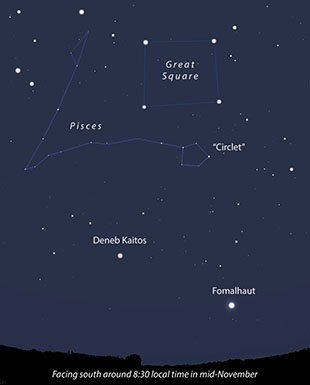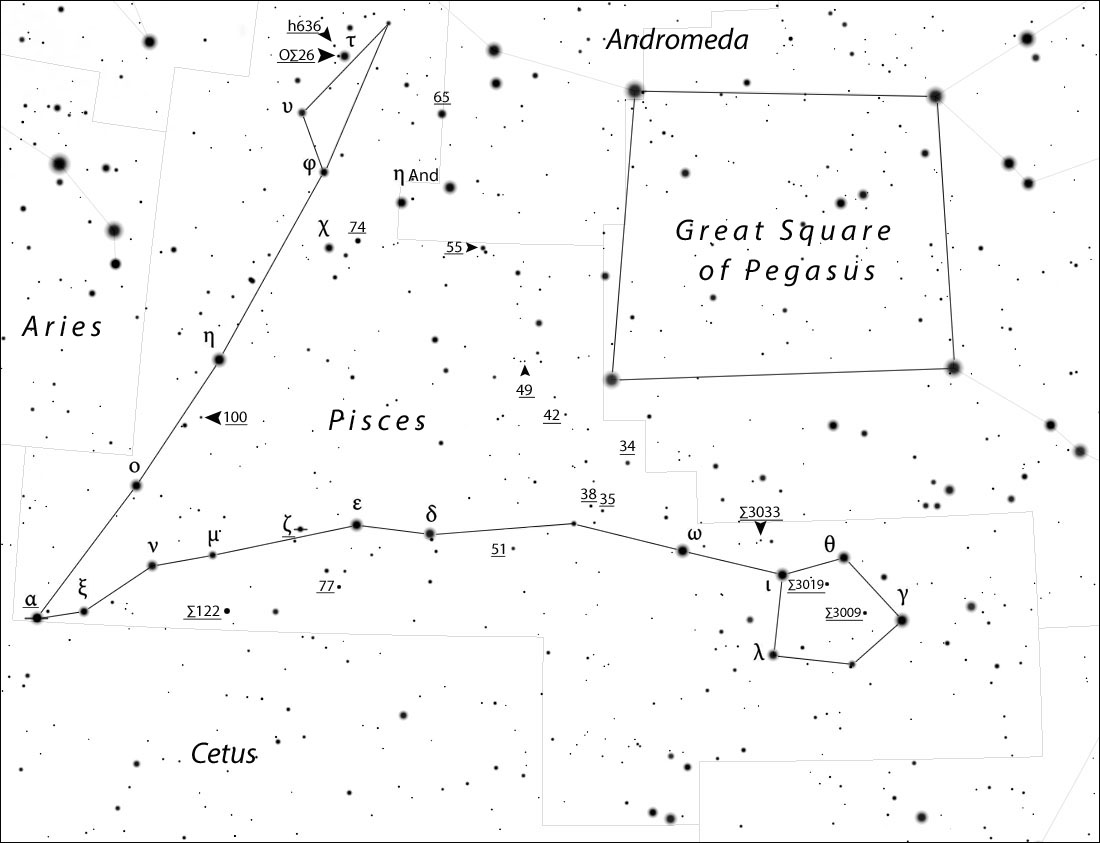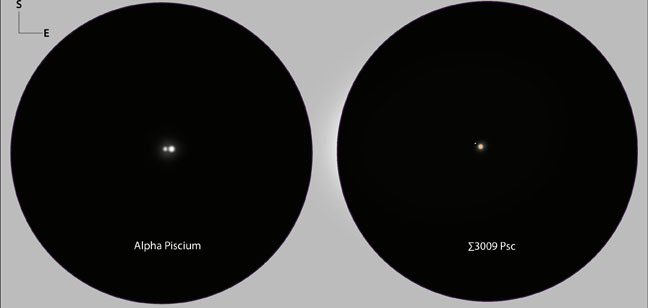Pisces, that sprawling constellation of faint stars easy to ignore, holds a treasure trove of double stars for small telescopes.

Stellarium
I don't fish. Just too impatient to sit in a boat and wait for a bite. But give me a telescope and I'll happily plop a line anywhere and observe till way past my bedtime — even in Pisces, the Fish, a faint constellation that meanders below and up the eastern side of the Great Square of Pegasus. Best known as a great place to hunt faint galaxies and galaxy clusters, Pisces is equally rich in double stars, many bright enough to see and split in a small telescope.
Pisces is ideally placed for study throughout the fall, and thanks to the Great Square, relatively easy to find despite its lack of bright stars. In my 10-inch f/6 scope I picked off almost 20 pairs over two nights, moving from one to the next on a mission of discovery. The double stars fell into two broad categories: unequal pairs with a significant magnitude difference between the primary and secondary stars, and equal (or nearly so) duos. Most were easy to split at low magnification (50-75×) with companions no fainter than about 10th magnitude. Only a few required 200× or higher to pry apart.
I love the diversity of double stars and how easy they are to observe in less than ideal conditions, whether under partly cloudy skies, in moonlight, or on nights of bumpy seeing. I read from right to left when it comes to the sky, so most of my deep-sky and double-star forays move from west to east in increasing right ascension.
Our fishing expedition begins with three "Struve doubles" in the Circlet asterism in western Pisces and proceeds east and north to the border of Aries. F. G. W. von Struve, a 19th-century German-Russian astronomer, was a prolific double star observer. Each of his discoveries received a catalog number preceded by the capital Greek letter, Sigma (Σ) or "STF." We'll meet him and his son, Otto von Struve, who also shared a fascination with double stars. The younger Struve's discoveries are preceded by "OΣ."

Stellarium with additions by the author
All the doubles were a pleasure to see, but those that really tickled my fancy are marked with three exclamation points. Have at it and have fun. Parse them out a half-dozen a night, or see them all at once and walk away from your scope with a serious case of double vision (if you'll excuse the pun).
Σ3009 (magnitudes 6.8, 8.8; separation 7″) !!!
Great beginnings! A delicate, close pair at low power with a bright, orange primary and considerably fainter companion. The magnitude difference adds drama to the scene.
Σ3019 (7.6, 8.6; 10.7″)
Easy and fairly close pair at low power.
Σ3033 (8.8, 8.8; 3.3″) !!!
I used 214× to split this equal-magnitude pair into two side-by-side pearls. Gorgeous!
34 Piscium (Psc) (5.5, 9.4; 7.7″)
The large magnitude difference made seeing the secondary iffy. Maybe you'll have better luck.
35 Psc (6.0, 7.6; 11.6″)
Easy, attractive low-power pair.
38 Psc (7.9, 7.8; 4.3″) !!!
Split nicely with 214×, two close-set, yellow stars in the same field with 35 Psc.
42 Psc (6.2, 10.1; 28.5″) !!!
The dramatic magnitude difference between primary and secondary makes this an aesthetically pleasing pair. The primary is bright orange and its companion decidedly faint, but averted vision makes it easy to spot.
49 Psc (6.9, 10.7; 20.9″)
Another very unequal double, but the wide separation makes finding the companion a snap.
51 Psc (5.7, 9.5; 27.5″)
Easy, unequal pair at low power.
55 Psc (5.4, 8.7; 6.5″) !!!
Fine, unequal, close pair with an orange primary. Challenging but satisfying to split at low power (76× for me); easy-peasy at 214×. I like to use the lowest possible magnification on double stars, just enough to cleanly separate them while maintaining as sharp an image as possible.
65 Psc (6.3, 6.3; 4.4″) !!!
Exquisite pair of citrine-colored gems oriented northwest-southeast. One of Pisces' prettiest doubles.
74 Psc [Psi (ψ) Psc] (5.6, 5.8; 30″) !!!
Lovely, bright equal pair, one yellow, the other white. Stands out boldly in a low-power field of view.
77 Psc (6.8, 7.6; 33″)
Zeta (ζ) Psc (5.6, 6.5; 23″)
Bright, wide, somewhat unequal pair.
Σ122 Psc (6.6, 8.6; 6.0″)
Although the magnitude difference is modest, the close separation made seeing the companion challenging but doable at 214×. Not visible at 76×.

Bob King
Alpha (α) Psc (4.2, 5.1; 1.8″) !!!
Superb, close double cleaves into two bright beads at 214×. The magnitude difference between primary and secondary adds a pleasing imbalance to the pair. Another one of Pisces' best!
100 Psc (7.3, 8.4; 15.5″)
Pretty pair, moderately close, nice at low magnification.
OΣ26 Psc (6.2, 10.0; 10.8″)
Unequal and close. A little tricky at 76× but visible.
h636 Psc (7.5, 10.0; 20.4″)
Similar to OΣ26 Psc in appearance and position angle, but the wider separation makes it easier to see the faint companion. The small "h" indicates a double star in 19th-century astronomer John Herschel's catalog.
If you work through these and crave more, check out this list of 59 fishy doubles from Eagle Creek Observatory.
 5
5








Comments
SNH
November 17, 2017 at 5:22 pm
Nice article, Bob. I'm not a huge double star fan personally. But I do love trying to split the closest ones I can in binoculars. Last fall I got quite the accomplishment in my 7x35 binoculars - I split Psi Piscum. That is something I encourage everyone to do because it actually wasn't as hard as you might imagine. But just remember to find the right Psi Pis since its the first one (Psi1)!
Scott
You must be logged in to post a comment.
Bob KingPost Author
November 19, 2017 at 9:51 pm
Hi Scott, thanks for sharing your success in the Psi split. Other readers should be encouraged to try the same.
You must be logged in to post a comment.
November 17, 2017 at 5:43 pm
Nice list, thanks!
You must be logged in to post a comment.
November 18, 2017 at 2:59 pm
Bob, I think the double-star discovering Otto von Struve was actually the son of FGW, although there was also a great-grandson astronomer of that name.
You must be logged in to post a comment.
Bob KingPost Author
November 19, 2017 at 9:49 pm
Thank you, goodricke1 for catching that slip up. Much appreciated and now changed 🙂
You must be logged in to post a comment.
You must be logged in to post a comment.